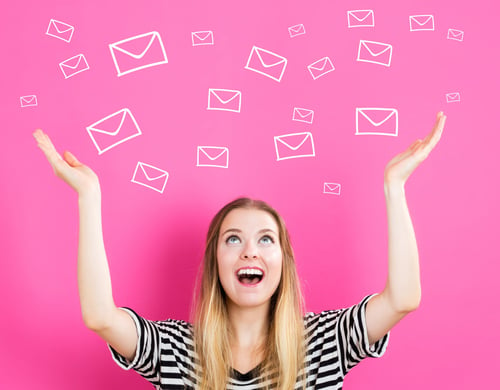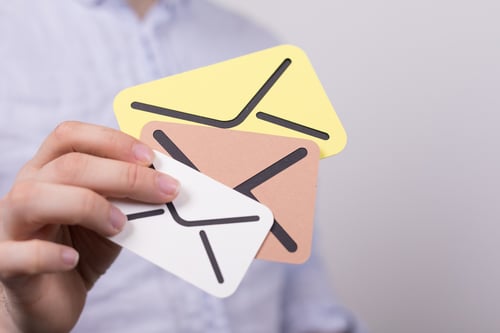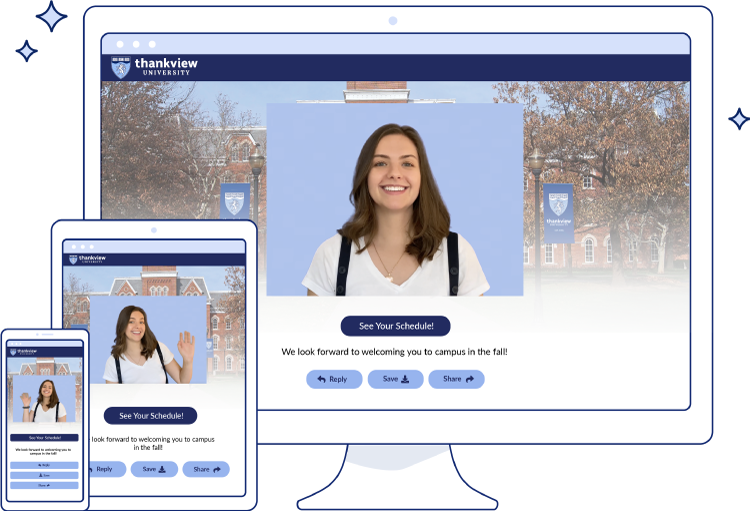How to Create Thank You Email Subject Lines That’ll Engage Your Supporters
Every day our inboxes get filled with emails from companies, organizations, and people trying to sell us things. It’s no wonder that it’s become harder to stand out in the sea of digital communications. With so much competition out there, getting your thank you email subject line right can make a huge difference.
Here’s our simple guide on how to make that happen. Here are amazing thank you email subject lines for fundraisers and donations, plus some best practice tips that’ll help you get it right.Why Send a Thank You Email?
Before we jump into how to create the best thank you note email subject line, let’s take a quick look at why thank you emails are so valuable.
Reaffirm Your Gratitude With Donors
We all want to feel appreciated — especially when we’ve contributed towards a cause that means a great deal to us. Sending thank you emails to donors lets them know you’re truly grateful, and that their contribution matters. This simple yet effective follow-up is a way to show your gratitude and give thanks to the people who helped you get one step closer to your goal.
Encourage a Stronger Relationship
While so many organizations, universities, small businesses, and nonprofits run fundraisers or have an active pool of donors, not all of them go the extra mile and build relationships with them. Thank you emails give you the opportunity to stand out and build a connection with your donors. This is especially true if you send a personalized video, thanking them for their most recent donation or contribution towards a specific cause. Find some great examples of this on the Thankie Awards page.
Create an Opportunity for Conversation and Sharing
Lots of organizations still rely on letters or generic, auto-generated emails as a way to give thanks to their donors. This is better than nothing, but it doesn’t leave much room for communication. Sending an intentional thank you email starts a conversation between you and your donors — especially if you include a question, ask for their feedback, or encourage them to hit reply to follow-up with you.
Sent a video message and happy to receive one back? Turn on video replies and your donors can respond with a video of their own. This works great for collecting testimonials that’ll help you grow further interest in your cause, or just as a nice way to open up conversation between you.
How to Write the Perfect Thank You Email Subject Line
Not sure how to make the right impact with your thank you note email subjects? Here’s our simple guide on how to write the perfect thank you email subject line. We’ve also included email examples to help inspire your own effective subject lines.
Make It Specific
Help your thank you email stand out from the crowd by being specific. Instead of a simple “Thank you,” add the name of the cause your donor has supported or the goal they’re helping you reach. Not only does this show that you’ve taken the time to consider their support more fully, but it makes it easier for them to remember and open your email.
Examples:
- “Thanks for helping us raise funds for our extension!”
- “We did it! Thanks for supporting our Student Emergency Fund”
- “Thanks for becoming a regular donor with XYZ University!”
Use Personalization
We all get so many emails every day that something with a generic subject line just doesn’t cut it anymore. Without personalization, your email could get lost in the list of others and not look attractive enough to open. Personalizing your thank you email subject line shows that you care and that your donor isn’t just a number to you.
One of the most common ways to personalize an email is to use a merge field to add the donor’s name. This is a great way to entice them to open up and read your email. You could also personalize your email subject line in other ways. For example, mention the donation amount or reference an action your donor has taken — like sharing your fundraiser with someone else.
Examples:
- “Thank you for your continued support, John”
- “Hi Sara! We’re grateful for your recent $200 donation”
- “Thank you for sharing our campaign, Lauren! We’re grateful”
Match Your Personality
Some email subject lines can be so boring. We’ve all seen them — the ones that tell you there’s 50% off the Winter Sale or a generic “thank you for subscribing” email. Make your email stand out from the sea of dull, corporate, and unimaginative messages by injecting your organization’s personality into your subject line.
You’ve spent a lot of time getting your brand message just right, so it only makes sense to have your subject line reflect this too. Refer to your style guide and give yourself permission to write a subject line that’s different, unique, and creative — if that suits your brand. Maybe you swap your “thank you” for a “thanks!” or your “wow” for an “OMG.” You can also think about what style of headline works for you. Some organizations can use humor to make their donors laugh, while others may want to go down the more formal route.
Examples:
- “Hey Tom! 👋 Thanks for supporting your favorite college”
- “Thank you for always supporting (Organization Name)”
- “Don’t miss this — here’s our thanks video to you!”
Include Powerful or Emotional Words
Your thank you email subject line for donations and fundraisers is there to get people’s attention, which you can do by using powerful words. These words inspire someone to take action, think, or feel moved by what you’re saying.
Examples of power words and phrases include things like “funny,” “love,” and “sweet,” while emotional words include “wonderful,” “spotlight,” and “valuable.” To find words like these for your headlines, try this list of 801+ power words. You can also run your proposed follow-up email subject line through a tool like this Headline Analyzer to get a feel for how balanced and impactful it might be.
Examples:
- “Thank you so much for your tremendous support”
- “Jack, your jaw-dropping donation means a lot to us!”
- “Thanks for helping us brighten up the world”
Add Emojis
If you want to create a different and more involved relationship with your donors, adding emojis to your emails could be the way to go. Recent research found that only 2% of organizations use emojis in subject lines to private clients or supporters, which means these social media favorites are a great way to stand out.
Used correctly, emojis can help you convey emotion without too many words — which is perfect if you want a subject line that works well on mobile. Some of the most popular emojis to feature in subject lines include ❤️, 😁, 😍, 🙌, and 👍.
Examples:
- “Thanks a bunch for your recent donation, Miles! 😍”
- “We’ve hit our target! A big ❤️ to you”
- “Here’s a sincere thanks from our grads to you 🎓”
Keep It Simple
The main goal of your digital thank you letter should be to convey how grateful you are for your donors’ support. You want them to know they matter to you, and that their support is valued. It can be tempting to use your email to promote something, or mention your latest blog post, but don’t overcomplicate the message — at least not in your subject line.
Example:
- “Thank you Evan. Your support means the world to us”
- “Thanks for supporting our latest campaign!”
- “Sending thanks from University of XYZ, with love”
Keep it simple, get people’s attention, and use your email content to take your thanks one step further. Once you’ve got them hooked, you have a lot more space to work with.
Email Subject Lines Best Practices
Now that you’re familiar with how to make an impact, it’s time to take a look at some best practices. Avoid simple pitfalls and create easy-to-read thank you email subject lines with these handy tips.
Write and Test Multiple Versions
It takes a lot to write a killer subject line in one go. While you might think you have it, we’d still recommend writing a couple of alternate versions. This gives you the opportunity to explore your ideas further, and you might come up with something even stronger.
Once you’ve got a handful of fundraising and donation email subject lines ready, don’t be tempted to immediately whittle them down until you’re left with one. Instead, split up (or segment) your email list into different groups and send each group a different headline. Once you’ve sent your email campaigns, you’ll then have lots of data to work through that’ll help you get a feel for which headline was the most effective. This can then be used to help you achieve even better results on future emails.
Don’t just stop there though. Get into the habit of questioning and testing every part of your email message, including A/B testing your ThankView videos.
Use Sentence Case
While a lot of us opt to use title case for headlines on websites and blogs, sentence case is often a better choice when it comes to email subject lines. Sentence case can be read quickly, as the letters are easier to distinguish from each other and there are fewer capital letters to deal with. It also looks and feels more casual, which suits a lot of modern organizations. With the amount of emails we receive every day, an easy-to-read title goes a long way.
Keep It Short and Sweet
When it comes to email subject lines, shorter is often better. While you could use a longer-than-average title to try and stand out, research from Mailchimp suggests using no more than nine words. You’ll also want your email subject line to be easy to read on mobile devices, as that’s where the majority of your open rates will come from. If you’re looking for a way to see what your subject line will look like on different devices, try this free generator.
Ensure Your Autofill Fields Work
There’s nothing more cringeworthy than receiving an email addressed to “FirstName LastName” instead of your own full name. Avoid this simple mistake by checking that your autofill fields work. To do this, send a test email to yourself and a few colleagues. Not only will this help you see if any of your fields aren’t working quite right, but it’s another opportunity to proofread, spot any issues with your email templates, and identify ways to make your thank you email even more powerful.
Create Thank You Email Subject Lines That Make a Difference
There’s plenty of inbox competition out there from other organizations, but that gives you a great opportunity to get creative and stand out. Write your subject lines with gratitude at the heart of your message and connect with your supporters in a way that feels natural for them. Combine this with emojis and powerful language, and test your titles until they’re just right.
Once you’ve sparked your supporters’ curiosity and they’ve opened your email, the rest of the message is your playground. Stay true to the message of thanks, and explore new ways to express how grateful you are for your donors’ support.
If you’re ready to explore adding customized video to your thank you emails, sign up for a free demo to see how ThankView can help you create an even more engaging experience.
